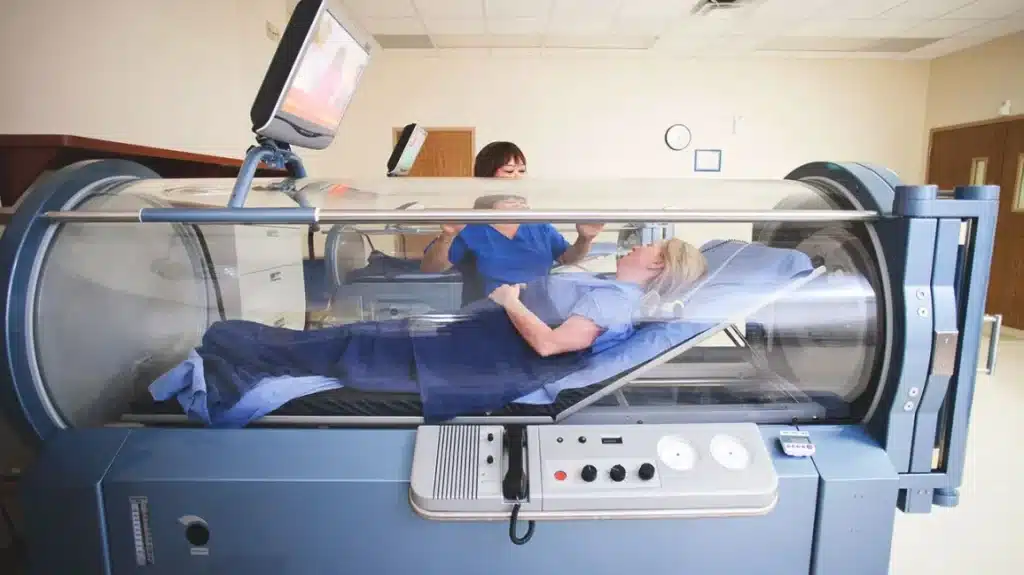
Hyperbaric Oxygen Therapy (HBOT) is a medical treatment that enhances the body’s natural healing process through the inhalation of 100% oxygen in a total body chamber, where atmospheric pressure is controlled and increased. Dr. Som offers insights into how hyperbaric chambers work, the mechanisms behind HBOT, and the diverse applications of this unique form of therapy.
Understanding Hyperbaric Chambers and Oxygen Therapy
A hyperbaric oxygen chamber is a highly specialized medical device that allows patients to breathe pure oxygen under increased atmospheric pressure. This environment significantly boosts the amount of oxygen your blood can carry, promoting healing and fighting infection more effectively.
Mechanisms of Hyperbaric Oxygen Therapy
The primary mechanism of HBOT is straightforward yet powerful: by breathing pure oxygen in a pressurized chamber, the amount of oxygen in the bloodstream is increased up to tenfold. This hyper-oxygenated blood circulates throughout the body, reaching damaged tissues and aiding in recovery by:
- Stimulating Collagen Production: Essential for wound healing, as collagen helps in rebuilding tissues.
- Enhancing White Blood Cell Action: White blood cells fight infection more effectively in a high-oxygen environment.
- Promoting New Blood Vessel Formation: Oxygen-rich environments stimulate angiogenesis, which is the formation of new blood vessels, improving blood flow to areas with impaired circulation.
- Reducing Inflammation: HBOT can decrease inflammation, aiding in the healing process and reducing pain.
Benefits of Hyperbaric Oxygen Therapy
HBOT offers numerous benefits across a wide range of medical conditions, including:
- Accelerated Healing of Wounds: Particularly beneficial for diabetic foot ulcers, post-surgical wounds, and injuries where blood flow is compromised.
- Treatment of Decompression Sickness: Commonly known as “the bends,” affecting divers who surface too quickly.
- Enhanced Recovery from Infections: Including serious infections like gangrene and bone infections (osteomyelitis).
- Management of Chronic Conditions: Such as radiation injury from cancer treatment, certain types of brain and ear injuries, and skin grafts or flaps at risk of tissue death.
Applications of Hyperbaric Medicine
Hyperbaric medicine has a broad range of applications, including but not limited to:
- Diabetic Wound Care: HBOT is particularly effective in healing chronic diabetic ulcers by enhancing oxygen delivery to impaired tissues.
- Neurological Conditions: Research is exploring the use of HBOT in the treatment of stroke, traumatic brain injuries, and certain neurodegenerative diseases.
- Cosmetic and Plastic Surgery Recovery: HBOT can reduce recovery time and enhance healing post-operatively.
- Sports Injuries: Athletes use HBOT to speed up the healing process of sports-related injuries, reducing downtime and improving recovery outcomes.
Conclusion
Hyperbaric Oxygen Therapy is a versatile treatment with a wide array of health benefits and applications. Its ability to deliver highly concentrated oxygen to the body’s tissues makes it a valuable tool in both acute and chronic disease management. Dr. Som advocates for the integration of HBOT into treatment plans where appropriate, given its potential to significantly enhance patient outcomes across various medical conditions. Whether for wound care, infection treatment, or aiding recovery from surgery, HBOT represents a cornerstone of modern hyperbaric medicine, offering hope and improved quality of life for many patients. Try it out today!
Previous Post Next Post